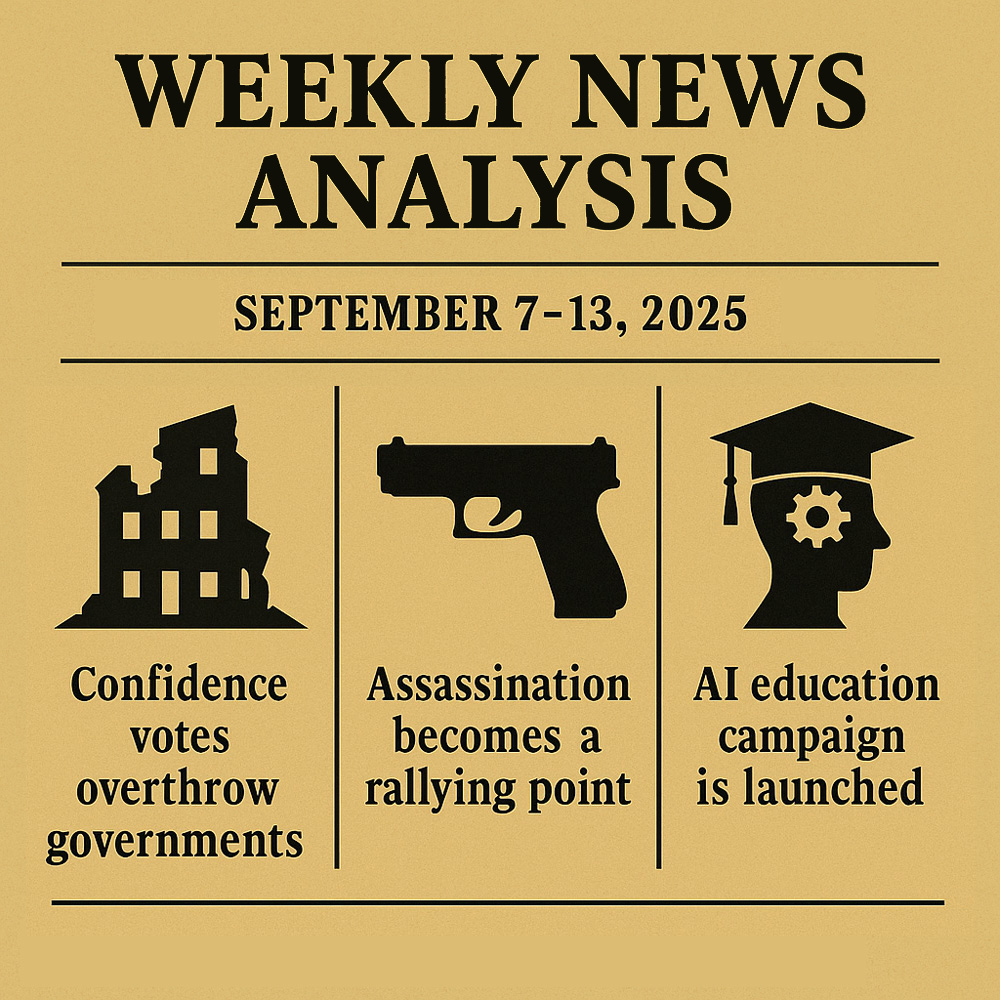
The week’s spectacle divides clearly into three acts of the same play. In Europe and South Asia, “collapses” happen on cue—confidence votes overthrow governments and street unrest justifies stronger managerial controls. These events are portrayed as sudden chaos, but the pattern consistently pushes societies toward technocratic oversight, characterized by budget restrictions, emergency alliances, and digitally mediated calming measures.
At home, an assassination becomes a rallying point for propaganda. Elite media fixates on identities and “extremism,” while officials float familiar solutions: platform crackdowns, “safety” protocols, and gun control. Meanwhile, Washington rolls out a smiling, corporate-backed AI education campaign that treats life as a series of training modules. The common thread in these stories is the increasing concentration of power through crises—fiscal, cultural, and technological—guided by a Great Reset and Agenda 2030 governance.
Managed collapses, managed futures
French parliament ousts prime minister, deepening political crisis - Reuters
What Comes Next for France After Another Government Collapse – TIME
Nepal 5th South Asian nation in 5 years to see abrupt regime change - Times of India
Nepal protests, social media ban, corruption, economic opportunity – ABC (Australia)
France’s no-confidence drama was framed as democratic accountability, but its actual effect is to weaken electoral mandates and boost fiscal “realism.” Lawmakers ousted François Bayrou’s government over deficit issues, with Paris under threat of credit rating cuts and a looming budget crisis—pressure that conveniently favors unelected financial officials and bureaucratic solutions over public debate.
TIME’s perspective is just as revealing: the “what comes next” narrative assumes a technocratic caretaker mindset—stability through managerial continuity rather than public consent. The focus isn't on “what do citizens want,” but on "how do institutions avoid disruption” as markets and Brussels observe. This view aligns with the broader reset mentality: crises are used to justify rule by expert oversight instead of political debate.
Shift to Nepal and the pattern intensifies. Regional media reports a swift series of regime changes across South Asia, a display of “abrupt” shifts that normalize instability as a pathway to greater external influence and internal monitoring. When instability becomes ongoing, “resilience” serves as a cover for permanent emergency measures—budget constraints, security coordination, and soft power tactics that promote aligned governance aims over national sovereignty.
On the ground, ABC documents protests, corruption grievances, and even social-media restrictions—classic tools of crowd control that can be activated during sensitive transitions. The rhetorical cycle is tight: unrest justifies controls on speech; controls lead to more unrest; each cycle expands the administrative boundaries. That is how “temporary” digital throttles become normalized infrastructure.
The televised storyline focuses on personalities and parliamentary drama; the behind-the-scenes result is policy continuity, characterized by debt discipline, regulatory alignment, and “resilience” platforms that integrate finance, security, and data governance. This reflects the principles of the Great Reset and Agenda 2030 in action: utilizing managed crises to tighten centralized standards and digital compliance tools, while presenting them as stability and sustainability. True revolutions are not broadcast because the real changes—control over budgets, data, and mobility—occur through administrative channels, not protests.
Crisis scripted for culture war
Charlie Kirk refused Netanyahu funding offer… - The Grayzone
Coverage of Charlie Kirk shooting and aftermath - BBC
Wild conspiracy theories swirl… - Daily Mail
Tyler Robinson, Charlie Kirk shooting suspect - CNN
Inscriptions on bullet casings: what we know - Snopes
The information battlefield surrounding the assassination was preloaded. Establishment outlets quickly stabilized the narrative: a lone young suspect, motive under investigation, and a warning against “misinformation.” That framework channels public emotion into approved channels—condemnation, calls for unity, and the inevitable policy discussions about online radicalization and weapon access. Even when details remain unresolved, the proposed solutions are clearly predetermined.
Parallel streams then categorize the audience: sensationalist outlets amplify oddities (hand signals, planes overhead), while fact-checkers clear away the viral debris. The cycle of spectacle and debunking serves the same purpose—reinforcing the official narrative as the rational middle and portraying dissent as contagion. Snopes plays the hygienic role: isolates claims, labels them, and restores narrative order.
Into this, identity scripts are injected. The event is framed within the leftist or extreme left ideologies on one side and the right-wing stochastic violence template on the other. Either way, the solution remains the same: increase monitoring, speech restrictions, and, most predictably, gun control measures. CNN’s questionable coverage and timeline feed into the prosecutorial narrative; the policy agenda follows closely behind, using grief to push previously stalled policies. The content changes; the structure does not.
The Grayzone, for its part, reveals geopolitical subtexts—Kirk’s alleged conflicts with pro-Israel donors and Netanyahu’s image management—reminding us that elite groups also challenge the narrative to protect their interests. But even these revelations are processed by the system: they excite, polarize, and ultimately get absorbed back into the control discourse—more surveillance, tighter borders, and fewer freedoms in the name of safety.
Even if the official story is true—that a lone actor sympathetic to leftist identitarian causes killed Kirk—the state-corporate machine won’t let the tragedy go to waste. It will be used to expand background checks, red-flag laws, and platform liability, which are all exactly opposite to the Second Amendment vision Kirk supported. The lesson isn’t about the shooter’s ideology; it’s about the mechanism: a crisis becomes the excuse to chip away at rights, carried out by the very authorities whose failures created the need for new powers.
Schooling the AI citizenry
Major Organizations Commit to Supporting AI Education - White House
Thinking Machines becomes OpenAI’s first services partner in APAC - AI News
Google’s top AI scientist: ‘learning how to learn’ is the next generation’s key skill - ABC News
The White House unveiled an impressive lineup of tech companies promising free tools, certifications, and “opportunities” for every student and teacher. The promises—Gemini for Education, Copilot for all K-12, credential pipelines via LinkedIn and OpenAI—may seem well-meaning; however, the structure places children and educators within platform ecosystems where identity, assessment, and opportunity are controlled by private algorithms connected to state objectives. That amounts to governance through curriculum—citizenship as ongoing skill development under corporate oversight.
Note the rhetoric: AI “literacy,” “pathways,” and “badges” define not only skills but also acceptable thought patterns. When Google’s senior scientist reframes education as “learning to learn,” it separates content from tradition, history, and moral context, and shifts the focus to the learner as a node to be optimized—fluid, updatable, and credentials-ready. The social contract moves from knowledge stewardship to adaptive compliance.
Internationally, partnership news like OpenAI’s APAC services expansion demonstrates how this architecture globalizes: standardize tools, seed partner networks, and export a governance model where “best practices” are layered on top of platform reliance. Agenda 2030’s education and digital identity initiatives converge here: assessing competencies and aligning behavior through interoperable systems that follow students into the labor market.
The promise of “free” is the lure; the cost is restriction. Once classrooms rely on proprietary copilots and vendor curricula, the state’s education mandate becomes shared management with tech giants. Content filters, safety measures, and bias protections are built into the tools themselves, regulating inquiry before a controversial question even reaches a teacher.
This is how a subtle social credit system forms without an official name: credentials serve as access passes, “trust and safety” functions as epistemic border control, and AI tutors act as both mentors and monitors. Under this reset approach, education no longer aims to cultivate free individuals but to produce interoperable users.
Staged Obedience
Across continents and sectors, the week advances the same managerial thesis: orchestrate “collapses,” weaponize grief, and rebrand mass training as liberation. Financial oversight in France, identity-framed outrage over an assassination, and the cheerful corporatization of K-12 AI all tighten the same loop—administrative convenience over consent, platforms over individuals.
The public is encouraged to choose sides in the spectacle: left vs. right, conspiracists vs. fact-checkers, boosters vs. skeptics. Meanwhile, the framing remains fixed: debt rules, speech controls, and credentialed dependence. True revolutions aren’t televised because the cameras focus on the actors, not the stagehands adjusting the set for a programmable society.
Listen to this week's news in verse for a quick recap!


